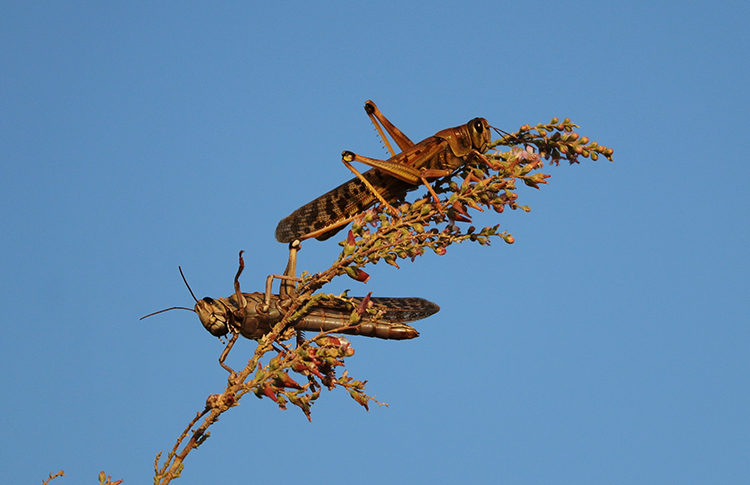Locust genome could be the key to ending devastating crop damage
- Like
- Digg
- Del
- Tumblr
- VKontakte
- Buffer
- Love This
- Odnoklassniki
- Meneame
- Blogger
- Amazon
- Yahoo Mail
- Gmail
- AOL
- Newsvine
- HackerNews
- Evernote
- MySpace
- Mail.ru
- Viadeo
- Line
- Comments
- Yummly
- SMS
- Viber
- Telegram
- Subscribe
- Skype
- Facebook Messenger
- Kakao
- LiveJournal
- Yammer
- Edgar
- Fintel
- Mix
- Instapaper
- Copy Link
Posted: 25 November 2020 | Joshua Minchin (New Food) | No comments yet
The desert locust has a notoriously complex genome structure, but scientists hope that by cracking their genetic code they can develop ‘intelligent pesticides’ that do not harm other organisms.


Locust swarms can cause damage to crops of biblical proportions.
A study deciphering the genetic material of the desert locust by researchers at the University of Leicester could help combat the crop-ravaging behaviour of the notorious insect pest, which currently contributes to hunger crises in developing countries.
It is hoped that the study will provide the basis for developing ‘intelligent pesticides’. These act with surgical precision by tapping into locust-specific signals in the nervous system, to either kill or disable their swarming behaviour, without harming other organisms.
The complete set of genetic information for the desert locust could have major international implications for countries in regions such as East Africa, the Arabian Peninsula and South-West Asia, which this year have suffered the worst desert locust crises in decades despite ongoing wide-spread control operations.
According to the Food and Agricultural Organisation (FAO), a swarm of locusts can contain around 40 million insects per square kilometre, which each day can eat the same amount of food as 35,000 people. The FAO estimates that 42 million people are currently facing severe food insecurity caused specifically by the desert locust.
Countries in East Africa have this year seen some of the worst swarms for decades. The Famine Early Warning System Network estimates that desert locusts in Somalia will eliminate enough crops to feed 280,000 people for six months this year. Coupled with an already unstable environment, it is estimated that 1.6 million people will move into the network’s ‘In Crisis’ or ‘Emergency’ categories – which mean families have significant food shortages.
Dr Tom Matheson, from the Department of Neuroscience, Psychology and Behaviour at the University of Leicester said: “The incredible devastation that these voracious insects can cause to food crops and pastures affects the livelihoods of hundreds of thousands of farmers and exacerbates the risks of starvation for the wider population in already vulnerable regions.
“The desert locust genome provides key information that could be a complete game-changer for the developing world, and a huge economic step forward for countries struggling to feed their populations.
“Tackling locust infestations and controlling swarms will never be easy because of the challenging conditions across the huge areas affected, but with the right information and research at hand, we hope that future approaches can become more effective.”
He added: “If climate change causes locust plagues to become the ‘new normal’, we will need all hands on deck by way of in-depth research and improved technology to help in the fight to control swarms.”
Desert locust swarms have, according to the World Bank, affected 23 countries in 2020 alone, from Pakistan to Tanzania. Authorities in affected countries have been carrying out aerial spraying of pesticides, but the scale of the infestation is often beyond local capacity. Desert locusts can travel up to 150km (95 miles) in a day, crossing national borders and rugged terrain in regions with little road infrastructure.
While locust swarms are infamous for the great damage they inflict to agriculture, their genetic material (‘genome’) is famed among researchers for its enormous size. At more than 8.8 billion base pairs of DNA (8.8 ‘giga-bases’), the desert locust genome is the largest insect genome sequenced to date and over 2.8 times larger than the human genome.1
Dr Swidbert Ott, also from the University of Leicester’s Neuroscience, Psychology, and Behaviour department, added: “We do not yet understand the genetic instructions that make locusts behave so differently from ordinary grasshoppers, and to such damaging effect. Until now, a major stumbling block has been the lack of the desert locust genome sequence that holds the answer to what makes a grasshopper a locust.
“We hope that our data can facilitate the development of novel, more sustainable methods of managing swarm outbreaks. With the information in our research now available, there is a unique opportunity for innovators to create an intelligent pesticide that targets locusts, but not other insects crucial to the ecosystem, such as pollinators.”
References
- https://f1000researchdata.s3.amazonaws.com/manuscripts/27753/d9896e0d-def0-4fe2-b9fd-926ca3396019_25148_-_heleen_verlinden.pdf?doi=10.12688/f1000research.25148.1&numberOfBrowsableCollections=27&numberOfBrowsableInstitutionalCollections=5&numberOfBrowsableGateways=26
Related topics
Environment, Food Security, Genetic modification (GMO), Pesticides, Refrigeration and freezing, Research & development, Supply chain
Related organisations
UN food and agriculture organization (FAO), University of Leicester, World Bank
Related regions
Africa, Asia Pacific & Oceania, Central and South Asia, Middle East









